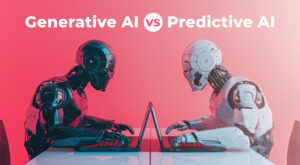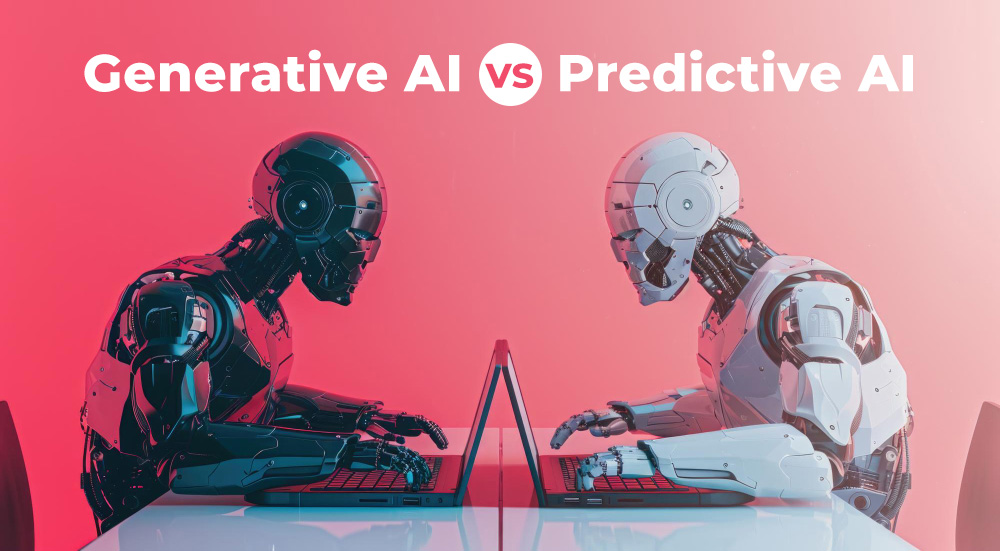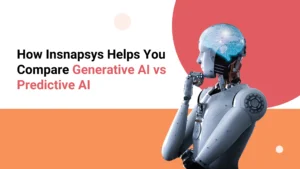Artificial intelligence has become an essential part of modern business operations and technology solutions. Among the different AI categories, two terms often discussed are Generative AI vs Predictive AI. While both rely on advanced machine learning, they serve different purposes and have unique applications.
Understanding Generative AI vs Predictive AI helps businesses choose the right approach for content creation, forecasting, and automation. In this guide, we will explore what each technology means, their differences, benefits, challenges, and real-world use cases.

What is Generative AI?
Generative AI refers to artificial intelligence systems that create new content. The main goal of Generative AI is to generate outputs such as text, images, videos, music, or even code that resembles human-created material. This is possible because Generative AI models learn from large datasets and apply patterns to produce original content.
How Generative AI Works
Generative AI uses models like GANs (Generative Adversarial Networks) and large language models such as GPT. These models analyze patterns from input data and create similar outputs. For example, if a Generative AI model is trained on thousands of images, it can generate a realistic new image that did not exist before.
Common Use Cases of Generative AI
- Writing blog articles and social media posts
- Creating images, videos, and digital artwork
- Developing chatbots and virtual assistants
- Generating product descriptions and marketing copy
Generative AI is widely used in creative industries because it automates repetitive tasks and provides unique ideas that support content marketing and branding strategies.

What is Predictive AI?
Predictive AI is focused on analyzing existing data to forecast future outcomes. It does not create new content like Generative AI but instead predicts trends, behaviors, or results based on historical data. Businesses use Predictive AI for decision-making and risk assessment.
How Predictive AI Works
Predictive AI uses statistical models, machine learning algorithms, and time-series analysis to identify patterns in data. These patterns help predict what is likely to happen in the future. For example, an e-commerce company can use Predictive AI to estimate future product demand.
Common Use Cases of Predictive AI
- Demand forecasting in retail
- Predicting customer behavior in marketing
- Fraud detection in banking and finance
- Predictive maintenance in manufacturing
- Healthcare predictions for disease risk
Predictive AI helps companies reduce uncertainty by providing data-driven insights that improve planning and operational efficiency.
Generative AI vs Predictive AI: Key Differences
The main differences between Generative AI vs Predictive AI come from their purpose, methods, and applications. Here are the major points:
Purpose and Goal
- Generative AI focuses on creating new content such as text, images, or videos.
- Predictive AI focuses on predicting future events using existing data.
Technology and Models
- Generative AI uses models like GANs and large language models such as GPT.
- Predictive AI uses regression analysis, decision trees, neural networks, and other predictive models.
Output Type
- Generative AI outputs new creative material that did not exist before.
- Predictive AI outputs probability-based predictions and forecasts.
Use Case Examples
- Generative AI: Content generation, digital art, video creation.
- Predictive AI: Sales forecasting, credit risk scoring, inventory planning.
Benefits of Generative AI vs Predictive AI
Both Generative AI and Predictive AI provide value, but in different ways.
Benefits of Generative AI
- Helps automate creative processes like writing and design
- Supports marketing by generating high-quality content quickly
- Reduces time spent on repetitive content tasks
- Provides scalable solutions for businesses needing frequent content updates
Benefits of Predictive AI
- Improves decision-making with accurate forecasts
- Helps businesses reduce risk through early warnings
- Enhances customer experience with personalized recommendations
- Optimizes resource allocation based on predictive analytics
Real-World Applications of Generative AI vs Predictive AI
The applications of Generative AI vs Predictive AI vary across industries.
Generative AI Applications
- Marketing and Advertising: Creating ad copy, social media content, and product descriptions.
- Entertainment: Generating music, videos, and gaming environments.
- Healthcare: Producing synthetic medical images for training purposes.
Predictive AI Applications
- Finance: Detecting fraud and predicting credit risk.
- Retail: Estimating product demand and managing inventory.
- Healthcare: Predicting disease outbreaks and patient risk levels.
- Manufacturing: Forecasting equipment failures and maintenance schedules.
Challenges of Generative AI vs Predictive AI
Both technologies face certain challenges that businesses must consider.
Challenges with Generative AI
- Requires large datasets for training
- Risk of generating inaccurate or biased content
- Ethical issues related to fake content or deepfakes
Challenges with Predictive AI
- Predictions depend on data quality and accuracy
- Can produce incorrect forecasts if models are not updated
- Privacy concerns with personal data usage
Which One Should You Choose: Generative AI vs Predictive AI?
The choice between Generative AI vs Predictive AI depends on your business needs.
- If your goal is content creation, such as writing articles, creating visuals, or generating ad copy, Generative AI is the right choice.
- If your goal is forecasting trends or analyzing future risks, then Predictive AI is more suitable.
- Many businesses combine both technologies for a complete AI strategy. For example, an e-commerce brand can use Predictive AI to forecast demand and Generative AI to write product descriptions.


Future of Generative AI vs Predictive AI
Both Generative AI and Predictive AI are expected to grow rapidly. Generative AI will continue to improve in producing realistic content, while Predictive AI will become more accurate with better algorithms and real-time data integration. Together, they will shape the future of automation, personalization, and decision-making in multiple industries.
FAQs on Generative AI vs Predictive AI
What is the main difference between Generative AI vs Predictive AI?
The main difference is that Generative AI creates new content, while Predictive AI forecasts outcomes based on past data.
Which is better for business: Generative AI or Predictive AI?
It depends on your goal. Generative AI is better for content creation, while Predictive AI is better for forecasting and analytics.
Can Generative AI and Predictive AI work together?
Yes, many businesses use both. Predictive AI can analyze market trends, and Generative AI can create marketing content based on those insights.
Is Generative AI used in predictive analytics?
No, Generative AI is not typically used for predictions. It is designed for content generation, while predictive analytics relies on Predictive AI.
What industries use Generative AI vs Predictive AI the most?
Generative AI is common in marketing, media, and design, while Predictive AI is widely used in finance, healthcare, and manufacturing.
Conclusion
When comparing Generative AI vs Predictive AI, it is clear that both technologies play important roles in modern business and technology. Generative AI supports creativity and content automation, while Predictive AI improves decision-making and risk management. Choosing the right one depends on your objectives, resources, and data availability.





